June 25, 2023
Most of the time, the artist finds herself in the position of a toddler trying to make circles and squares fit into squares and circles. The only difference is that things often fit in an unexpected way: she has to notice the moment a circle fits into a square.
April 19, 2023
Through the clay, the child carved out deep tunnels to figure the nostrils. Her gestures were more thoughtful than the gaping holes suggested. “If a soul inhabits this portrait," she imagined, "one should make sure that it receives sufficient amounts of oxygen." Later on, she would learn the delicacy of sculptural conventions, and leave two shallow, bean-shaped marks on the base of the nose. No more tunnels in the mud, but a shrine for two seeds.
![]()
E. Lanteri, Fig 52 in ‘Modelling: a guide for teachers and students’, 1902
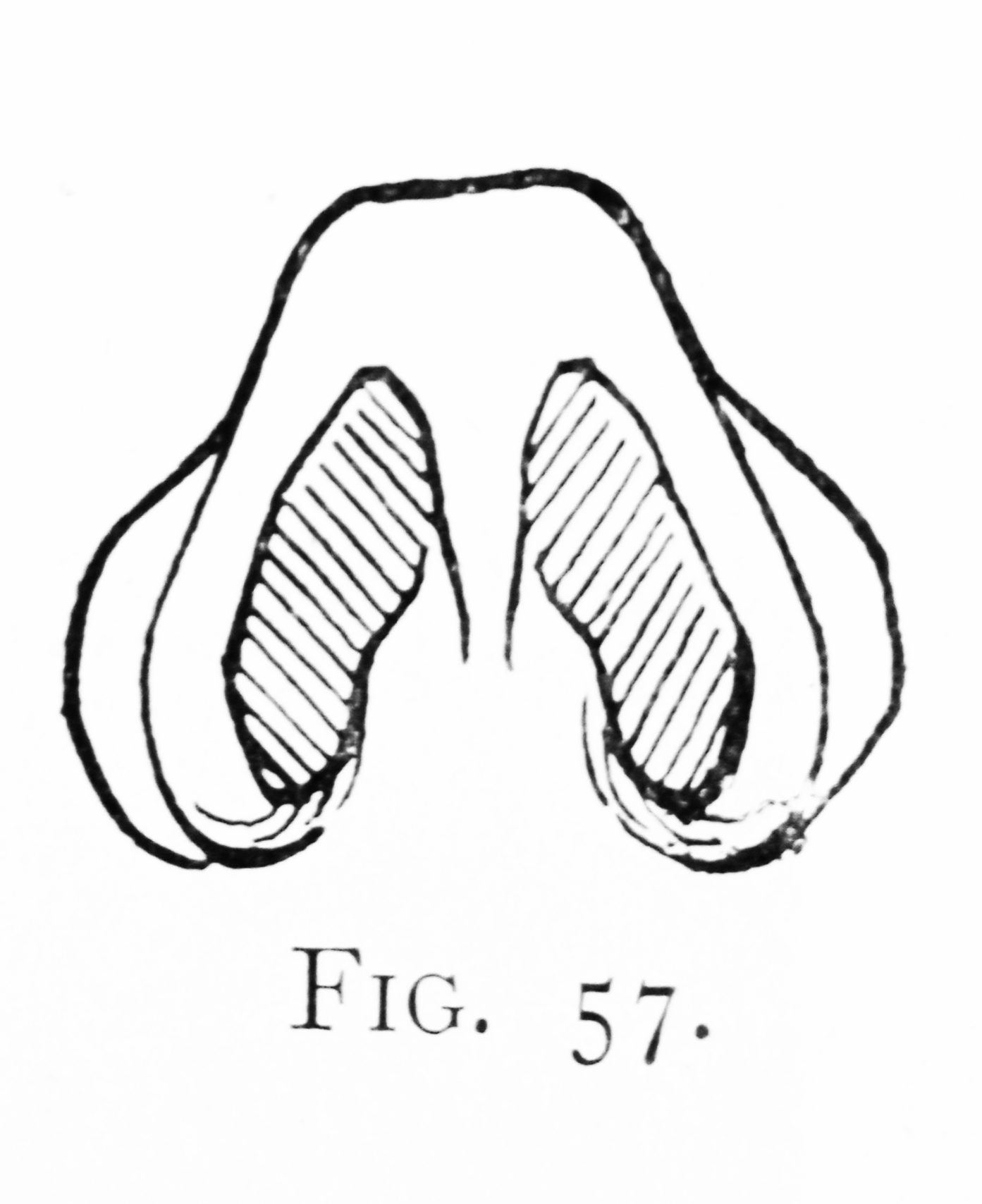
April 5, 2023
I looked out of the window; the sky so bright, my own body could not be excluded from it. I perceived the passing of my eye floaters on the blue surface, like water striders gliding on top of a pool. I could hardly recognise these debris as a part of myself, or remember that their liveliness was confined to that of my vitreous body.
(dead flies, moved by an alive sky)
(dead flies, moved by an alive sky)
March 7, 2023
I see skin — it is mine but feels foreign — the goose bumps on the inner side of my legs. To represent this, I cannot draw or photograph it. What I experience has little in common with a naturalistic rendering of skin. One’s own goosebump: the animality of scales, an erectility that would deserve lusher symbols.
January 20, 2023
I do not look at myself, therefore my whole body is equally present, equally invisible in each thing I see.
January 15, 2023
ecstatic yet not blissful
a fruit in a still life
crying out its own seeds
a fruit in a still life
crying out its own seeds
December 8, 2022
At the end of the 19th century, an Aboriginal man was presented with the first photograph of himself. The man belonged to the Totem of the Kangaroo. After considering the picture with attention, he commented: ‘This man exactly looks like me, just as a kangaroo does.’ This is how ethnographers understood the complete identification between the Aboriginals and their totem. (1)
Beyond totems, this remark might elicit how, as a model, I recognise myself in the things of the drawing room, while I do not identify with the portraits that are made of me. Being part of an inanimate world, I experience kinship as a striking likeness.
(1) W.B. Spencer and F.J. Gillen, The Native Tribes of Central Australia, London, 1899, p. 202.
Beyond totems, this remark might elicit how, as a model, I recognise myself in the things of the drawing room, while I do not identify with the portraits that are made of me. Being part of an inanimate world, I experience kinship as a striking likeness.
(1) W.B. Spencer and F.J. Gillen, The Native Tribes of Central Australia, London, 1899, p. 202.
November 29, 2022
I must have been too young to follow the whole development of the movie, and I only remember the laconic plot of the first scene: a man makes love to a statue. What my memory has registered are the circumstances: the back of the man, which itself seemed sculpted; the quietness of the place, which resembled a temple (in my memory, the movie was Asian, but I have not been able to trace it back).
I do remember the beauty of the images as well as the shame of being fascinated by such a gross act. The same ambiguity accompanied my discovery of the myth of Pygmalion: the delicacy of Ovid's writing wasted on the story of a man incapable of love — the very incapacity to love spilled into an object — but the evocation of the warm, pulsating marble was enough to put the inanimate to rights.
I have not been able to find the same sympathy for Jan Wolker's writing, as he describes an intercourse with a statue in 'Kort Amerikaans'. The torso is reduced to its sealed thighs and cold surface, and its necrophilic charm participates in an intrigue that ultimately leads to the main character's death.
I do not mourn the dead, as I stand on the statue's side. The torso described in the story of Kort Amerikaans actually exists, and is displayed in the sculpture class of Ars Aemula Naturae. I pose in this Leiden-based academy every Wednesday evening, near this statue. If intent gazing can be a form of love, I wish my own iconophilia would counteract the previous one.
I do remember the beauty of the images as well as the shame of being fascinated by such a gross act. The same ambiguity accompanied my discovery of the myth of Pygmalion: the delicacy of Ovid's writing wasted on the story of a man incapable of love — the very incapacity to love spilled into an object — but the evocation of the warm, pulsating marble was enough to put the inanimate to rights.
I have not been able to find the same sympathy for Jan Wolker's writing, as he describes an intercourse with a statue in 'Kort Amerikaans'. The torso is reduced to its sealed thighs and cold surface, and its necrophilic charm participates in an intrigue that ultimately leads to the main character's death.
I do not mourn the dead, as I stand on the statue's side. The torso described in the story of Kort Amerikaans actually exists, and is displayed in the sculpture class of Ars Aemula Naturae. I pose in this Leiden-based academy every Wednesday evening, near this statue. If intent gazing can be a form of love, I wish my own iconophilia would counteract the previous one.
November 27, 2022
I felt the pull of the background, my own mask among the casts on the studio wall.
September 21, 2022
In an extreme contrapposto, my left foot hardly touched the ground, and I held onto this view to prevent me from falling:
In front of me was hanging a spider plant - or perhaps I should use the plural form, as its complete genealogy was cascading from the ceiling. It did not move, but its mere suspension was enough to raise my attention, and I stared, naive as a newborn fascinated by a mobile.
One could call it sympathetic magic: the weightlessness of this sight kept my body in place.
And indeed, the sculptures made after me remained a distant interpretation: not the copy of a particular woman reflecting the idea of the Woman, but the image of a woman imitating a plant in a joint process of weightlessness.
In front of me was hanging a spider plant - or perhaps I should use the plural form, as its complete genealogy was cascading from the ceiling. It did not move, but its mere suspension was enough to raise my attention, and I stared, naive as a newborn fascinated by a mobile.
One could call it sympathetic magic: the weightlessness of this sight kept my body in place.
And indeed, the sculptures made after me remained a distant interpretation: not the copy of a particular woman reflecting the idea of the Woman, but the image of a woman imitating a plant in a joint process of weightlessness.
July 26, 2022
Not taking the place of the woman being looked at - but, in the following situation, becoming the leaf:
![]() 'A Victorian drawing class', plate 103 in E. H. Gombrich, Art and Illusion, Phaidon Press, Oxford, 1956 (1988)
'A Victorian drawing class', plate 103 in E. H. Gombrich, Art and Illusion, Phaidon Press, Oxford, 1956 (1988)
 'A Victorian drawing class', plate 103 in E. H. Gombrich, Art and Illusion, Phaidon Press, Oxford, 1956 (1988)
'A Victorian drawing class', plate 103 in E. H. Gombrich, Art and Illusion, Phaidon Press, Oxford, 1956 (1988)July 4, 2022
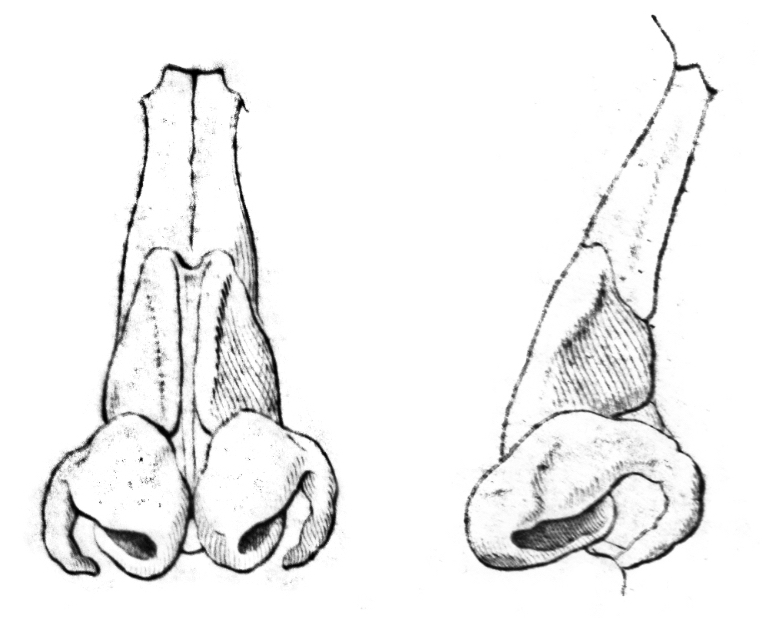
Cartilage nose, details of a plate observed at the Dutch Atelier of Realistic Art, 2022
June 19, 2022
Unlike Schrödinger's cat, the model could remain alive-and-dead while constantly being observed.
June 18, 2022
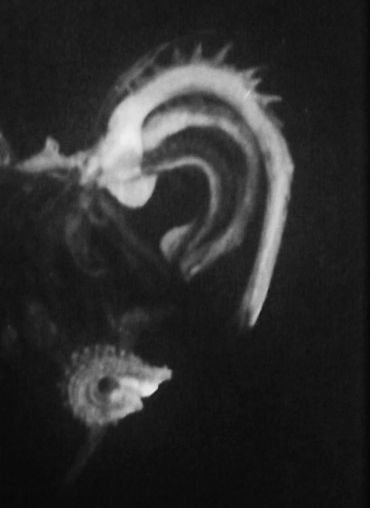

Above: Dry flower, found object (scanned)
Below: Plate from Italian Painters, A Critical Study Of Their Works, Giovanni Morelli, 1900
June 17, 2022
From where I am, I don’t know anything about painting: the easel turns its back on me. There, paint ceases to be a visual surface; it is the sound of a matter (the matter propelled out of the tube with a monstrous flatus).
June 15, 2022
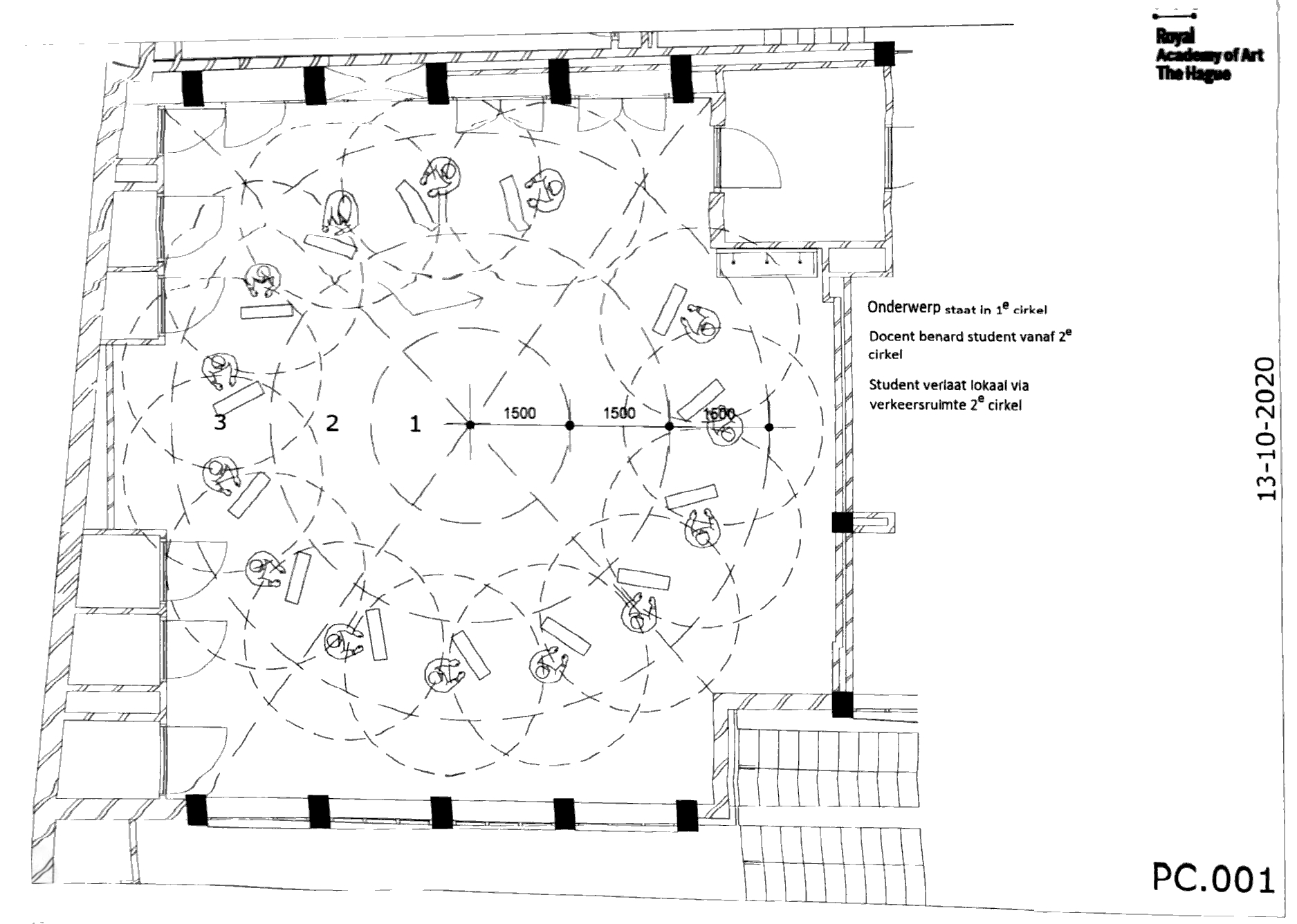 Relative placements of the model, students and teacher in BC001, scanned at the Royal Academy during the second covid-wave, late fall 2020
Relative placements of the model, students and teacher in BC001, scanned at the Royal Academy during the second covid-wave, late fall 2020June 14, 2022
Since I was a child, I often dream that I can fly. It always goes in the same way: I walk, my steps grow bigger and bigger, my feet leave the ground, and my arms start performing breaststroke gestures. Each time, these movements come back to me with the same naturalness, and I get to wonder how I could have forgotten that gravity is just another convention one may object against. From my dream, I observe my waking life as flightless animal, and assume that my own obedience to the laws of physics is the only thing that prevents me from flying.
And similarly, to sit still for hours, an altered mindset has to support my effort. I confound myself to what I see, and the immobily of my field of view becomes the fundament of my own. As it were, my body turns into a sort of imaginary building, whose stability would be guaranteed by the permanence of the landscape at the top of its belvedere. And so it goes: I embrace a role, and cease to be a person, in order to become a relation to the world.
These two experiences were combined in a more recent dream. I sat still in the middle of the drawing class, but my mind started wandering through the classroom. It found its way through the beams of the easels, right above the pots of gouache (the sweetness of their smell struck me). I was myself part of the ambient atmosphere, among the air breathed by all. “I should turn this experience into a flying performance,” I thought while sleeping. “And I will do so as soon as I am awake.”
And similarly, to sit still for hours, an altered mindset has to support my effort. I confound myself to what I see, and the immobily of my field of view becomes the fundament of my own. As it were, my body turns into a sort of imaginary building, whose stability would be guaranteed by the permanence of the landscape at the top of its belvedere. And so it goes: I embrace a role, and cease to be a person, in order to become a relation to the world.
These two experiences were combined in a more recent dream. I sat still in the middle of the drawing class, but my mind started wandering through the classroom. It found its way through the beams of the easels, right above the pots of gouache (the sweetness of their smell struck me). I was myself part of the ambient atmosphere, among the air breathed by all. “I should turn this experience into a flying performance,” I thought while sleeping. “And I will do so as soon as I am awake.”
June 6, 2022
Cosmic love — could one’s love for the planet be anything other than an asymmetrical power relationship, in its most disproportionate form?
June 1, 2022
She said that the sanitary situation had led her to leave the portrait course for a while, and that she had decided to practice an activity closer to home. In those times, it was safer not to take the train.
Instead, she enrolled in a firearm training course, and could find some parallels between the practice of drawing and that of shooting. It is about accurate observation, she remarked - and reaching out the arm, with an assured gesture. In that respect, both activities resulted in the same muscle soreness.
In the light of her experience, she started drawing again. Neither better, nor worse; but the time she had spent observing a peer revealed itself as a needless sacrifice.
Instead, she enrolled in a firearm training course, and could find some parallels between the practice of drawing and that of shooting. It is about accurate observation, she remarked - and reaching out the arm, with an assured gesture. In that respect, both activities resulted in the same muscle soreness.
In the light of her experience, she started drawing again. Neither better, nor worse; but the time she had spent observing a peer revealed itself as a needless sacrifice.
May 30, 2022
Nude beyond eroticism (towards the nudity of cats and dogs, and their genitals plainly aligned on their South Face).
![]() ‘Der Hund’, plate 8 in: Wilhelm Ellenberger, Hermann Baum, and Hermann Dittrich, Handbuch der Anatomie der Tiere für Künstler, Dieterichsche Verlagsbuchhandlung, Leipzig, 1911-1925.
‘Der Hund’, plate 8 in: Wilhelm Ellenberger, Hermann Baum, and Hermann Dittrich, Handbuch der Anatomie der Tiere für Künstler, Dieterichsche Verlagsbuchhandlung, Leipzig, 1911-1925.
 ‘Der Hund’, plate 8 in: Wilhelm Ellenberger, Hermann Baum, and Hermann Dittrich, Handbuch der Anatomie der Tiere für Künstler, Dieterichsche Verlagsbuchhandlung, Leipzig, 1911-1925.
‘Der Hund’, plate 8 in: Wilhelm Ellenberger, Hermann Baum, and Hermann Dittrich, Handbuch der Anatomie der Tiere für Künstler, Dieterichsche Verlagsbuchhandlung, Leipzig, 1911-1925.May 25, 2022
Shy, shy as an urchin - her anus exposed to the currents, and a more secretive mouth, communicating only with the stone.
April 9, 2022
The artists liked working after a model, but were perfectly able to draw without; likewise, the model could practice motionlessness on her own.
March 29, 2022

Imagined Situation at Ars Aemula Naturae, two slides for a stereoscope, 2022
March 16, 2022
Inevitably, the torso displayed in the sculpture room of Ars is one of the artworks I have observed the longest. Whether I like this piece or not is besides the point —
working as a model in this Leiden-based academy, I had to get accustomed to its sight.
I do acknowledge its superiority when it comes to age and fame. The sculpture had already become a litterary topos before I came into being, inspiring a book, Kort Amerikaans, written in 1962 by the Dutch writer Jan Wolkers. Seventeen years later, the same torso appeared in the movie adaptation of the book.
In these two works, the torso stands for lust, and alleviates the sexual misery of the main character. I must say that the loneliness of this man never triggered my interest, as the melancholy of the sculpture itself seemed closer to mine.
Upper picture: Derek de Lint in Kort Amerikaans, detail of the LP of the soundtrack of the film, 1979
I do acknowledge its superiority when it comes to age and fame. The sculpture had already become a litterary topos before I came into being, inspiring a book, Kort Amerikaans, written in 1962 by the Dutch writer Jan Wolkers. Seventeen years later, the same torso appeared in the movie adaptation of the book.
In these two works, the torso stands for lust, and alleviates the sexual misery of the main character. I must say that the loneliness of this man never triggered my interest, as the melancholy of the sculpture itself seemed closer to mine.
Upper picture: Derek de Lint in Kort Amerikaans, detail of the LP of the soundtrack of the film, 1979
February 13, 2022
Plaster casts, wild boar trophies, glass vessels, fruits, masks: these are the things draughtsmen tend to place in their still-lives. They carefully gather various textures, and just as many different shapes. But when it comes to still-lives, diversity remains restrained to a limited set of items.
As common components of the drawing room, models and masks are likely to face each other. To my surprise, I came across the very same mask in two different studios, the one in the Hague, the other in Leiden. The bird it represented did not deserve the attention it enjoyed. Yet, the interior, the part that is never drawn, excited my curiosity. I wish I could wear this mask, inside out, before sitting at my familiar place.
As common components of the drawing room, models and masks are likely to face each other. To my surprise, I came across the very same mask in two different studios, the one in the Hague, the other in Leiden. The bird it represented did not deserve the attention it enjoyed. Yet, the interior, the part that is never drawn, excited my curiosity. I wish I could wear this mask, inside out, before sitting at my familiar place.
February 2, 2022
Mould-making (altered studio situation at Ars Aemula Naturae), 2022
January 15, 2022
May silence spread as unavoidably as sound.
August 2, 2021
My mother was a professor of mathematics. As a daily activity, she used to cover scrap paper and blackboards with digits, figures, and braces. She had a good drawing hand.
Every now and then, she used to take me to her office. I observed her tracing these arabesques, and I accepted that the sense of these things would always escape me, and I liked them for this precise reason.
I was just dazzled by the sureness of her movement and by her ability to dive into a mathematical model and unravel its mysteries through a series of empty signs.
But she performed all this in a mundane way. She produced clarity like a laundress crafts cleanliness. She was making a living from this repetitive task.
Next to her, the draughts were neatly piling up. Most of them failed to solve the problem, and she had to start again.
One searches for researchers who find, and one finds researchers who search. She felt entitled to a certain amount of pointlessness, for she was paid to perform the skilled sacrifice of her time without always hitting the nail on the head.
The signs supporting such unfruitful attempts remained mere decorations. I was allowed to draw on the verso of these sheets. The childish sun, grass, and animals on the back remained far removed from the beauty of nature, just as the skillful signs on the recto kept a certain distance from the unspeakable beauty of the mathematical truth.
Every now and then, she used to take me to her office. I observed her tracing these arabesques, and I accepted that the sense of these things would always escape me, and I liked them for this precise reason.
I was just dazzled by the sureness of her movement and by her ability to dive into a mathematical model and unravel its mysteries through a series of empty signs.
But she performed all this in a mundane way. She produced clarity like a laundress crafts cleanliness. She was making a living from this repetitive task.
Next to her, the draughts were neatly piling up. Most of them failed to solve the problem, and she had to start again.
One searches for researchers who find, and one finds researchers who search. She felt entitled to a certain amount of pointlessness, for she was paid to perform the skilled sacrifice of her time without always hitting the nail on the head.
The signs supporting such unfruitful attempts remained mere decorations. I was allowed to draw on the verso of these sheets. The childish sun, grass, and animals on the back remained far removed from the beauty of nature, just as the skillful signs on the recto kept a certain distance from the unspeakable beauty of the mathematical truth.
June 20, 2021
She liked drawing her. Not exactly because of her calm, rather for the slight changes of expression that each moment casted on her face, which yet remained serene. She could relate to this face as Anton Mauve related to his dunes (swift clouds on an otherwise placid landscape).
May 27, 2021

A work is finished when it redoubles the model's physical engagement.
Picture after: Skeleton and model, by Ryan Somma, retrieved from: commons.wikimedia.org/wiki/Cryptobranchus_alleganiensis
May 26, 2021
She could only teach
what she had learned:
not how to draw a hand
— but the desire to seize,
and the desire not to seize.
what she had learned:
not how to draw a hand
— but the desire to seize,
and the desire not to seize.
May 25, 2021
The painter showed his pupil how each element reflected light, in such a way that neighbouring objects discretely shared similar shades, leading to an overarching unity in the colouring of the image.
“In this way,” he explained, “you will notice how drapery lightens the skin of the model, while the model reflects an earthly tone in the otherwise immaculate drapery she lays on. All the elements of a given room participate in the same painterly coherence.”
In her mind, the model addressed other wishes to the pupil: “May you one day look even further than he does, and paint your own reflected light, as you also belong to the scene you are observing.”
“In this way,” he explained, “you will notice how drapery lightens the skin of the model, while the model reflects an earthly tone in the otherwise immaculate drapery she lays on. All the elements of a given room participate in the same painterly coherence.”
In her mind, the model addressed other wishes to the pupil: “May you one day look even further than he does, and paint your own reflected light, as you also belong to the scene you are observing.”
May 13, 2021
Heard while posing:
By now we quite know what she looks like; yet, no one knows what she actually thinks.
I hushed and did not say:
I am aware of it all, and can feel the mapping of my skin, or the measuring of my skull – what this skull contains remains my own.
Another voice raised:
Maybe she elaborates a grocery list?
This very idea scared me: the idea of inner worlds containing nothing but grocery lists.
By now we quite know what she looks like; yet, no one knows what she actually thinks.
I hushed and did not say:
I am aware of it all, and can feel the mapping of my skin, or the measuring of my skull – what this skull contains remains my own.
Another voice raised:
Maybe she elaborates a grocery list?
This very idea scared me: the idea of inner worlds containing nothing but grocery lists.
May 12, 2021
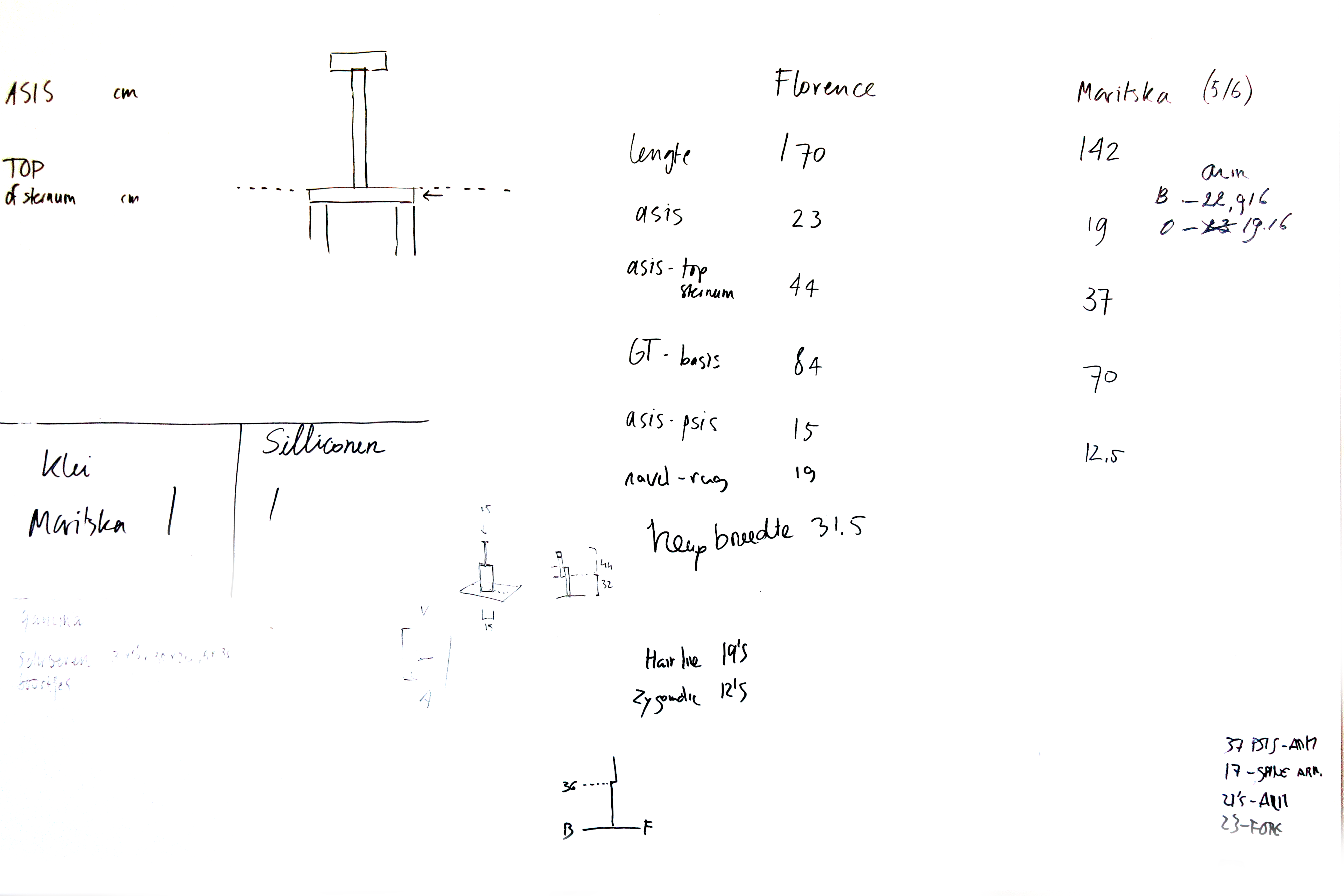
Personal measurements, as noted by a group of sculptors, May 2021
May 7, 2021
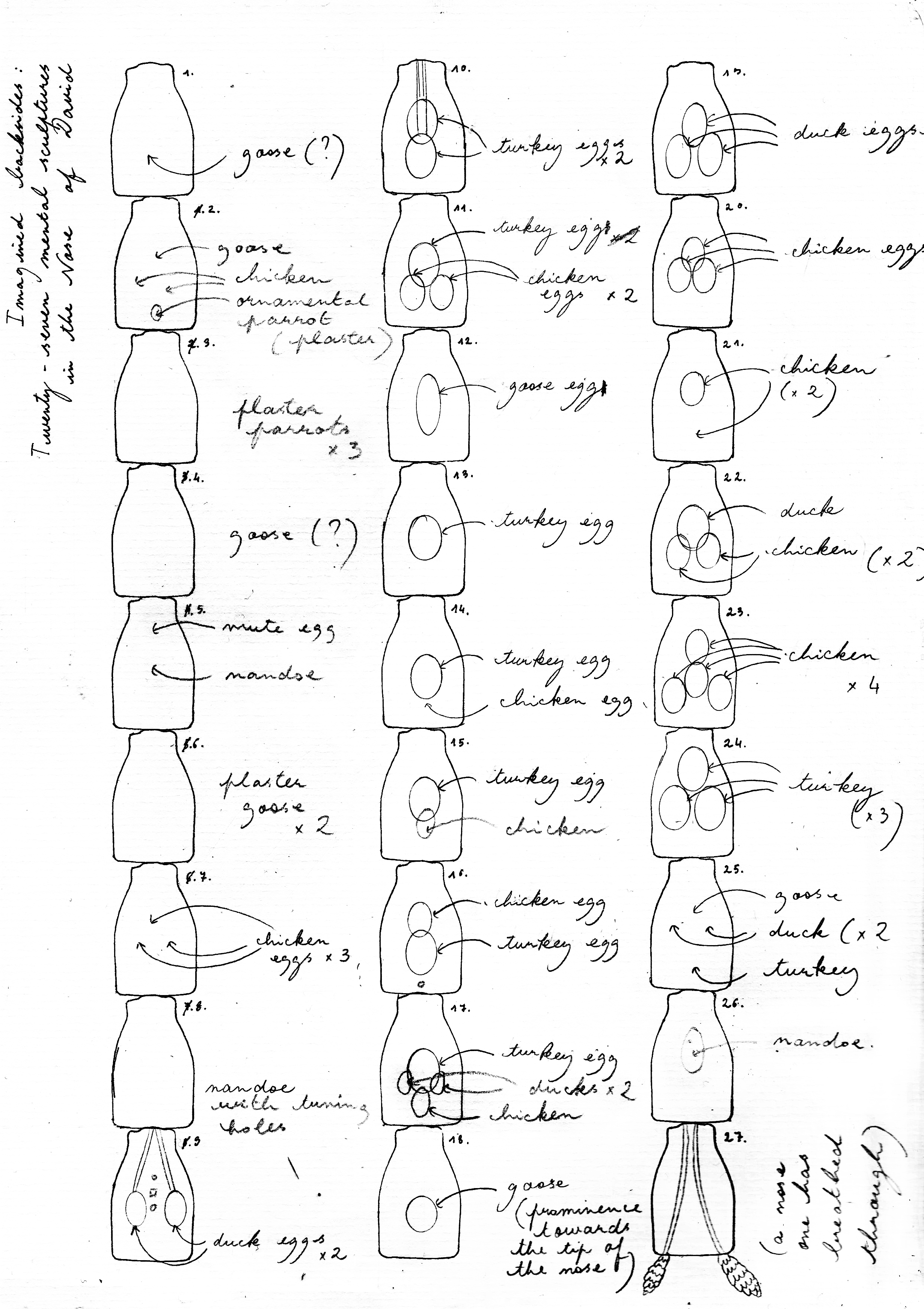 Imagined backsides: Twenty-seven mental sculptures in the Nose of David, 2021
Imagined backsides: Twenty-seven mental sculptures in the Nose of David, 2021April 16, 2021
“I refuse to symbolise the human face,” the egg-shape asserted, “as the only thing I stand for is an unborn chicken.”
March 25, 2021
Today I posed in an ugly room, and at first, I felt little affinity with my surroundings. But as I changed position, my eyes fell on an anatomical plate, a plaster relief, representing an écorché from the side.
I could behold the muscles of his neck — slender, almost vegetal, apparently shaped by the wish to reach the sun. I looked at him with the same involvement as he did, his flat face turned towards the slit of the curtains, which remained closed.
The pose was soon over, and so was the afternoon: I could approach the plate from close-up, and tried to photograph it. But the scene lacked light, and I had to open the curtains. Behind them, on the window sill, appeared five casts of a fennel.
I briefly considered stealing them - this transgression seemed almost natural, as though my own organs had gone afield, and that I could recollect them. But however mine, I left these anatomies where they were, resting in their own sun.
![Still life at the Breitner academy, 2021]() Still life at the Breitner academy, 2021
Still life at the Breitner academy, 2021
I could behold the muscles of his neck — slender, almost vegetal, apparently shaped by the wish to reach the sun. I looked at him with the same involvement as he did, his flat face turned towards the slit of the curtains, which remained closed.
The pose was soon over, and so was the afternoon: I could approach the plate from close-up, and tried to photograph it. But the scene lacked light, and I had to open the curtains. Behind them, on the window sill, appeared five casts of a fennel.
I briefly considered stealing them - this transgression seemed almost natural, as though my own organs had gone afield, and that I could recollect them. But however mine, I left these anatomies where they were, resting in their own sun.
February 23, 2020
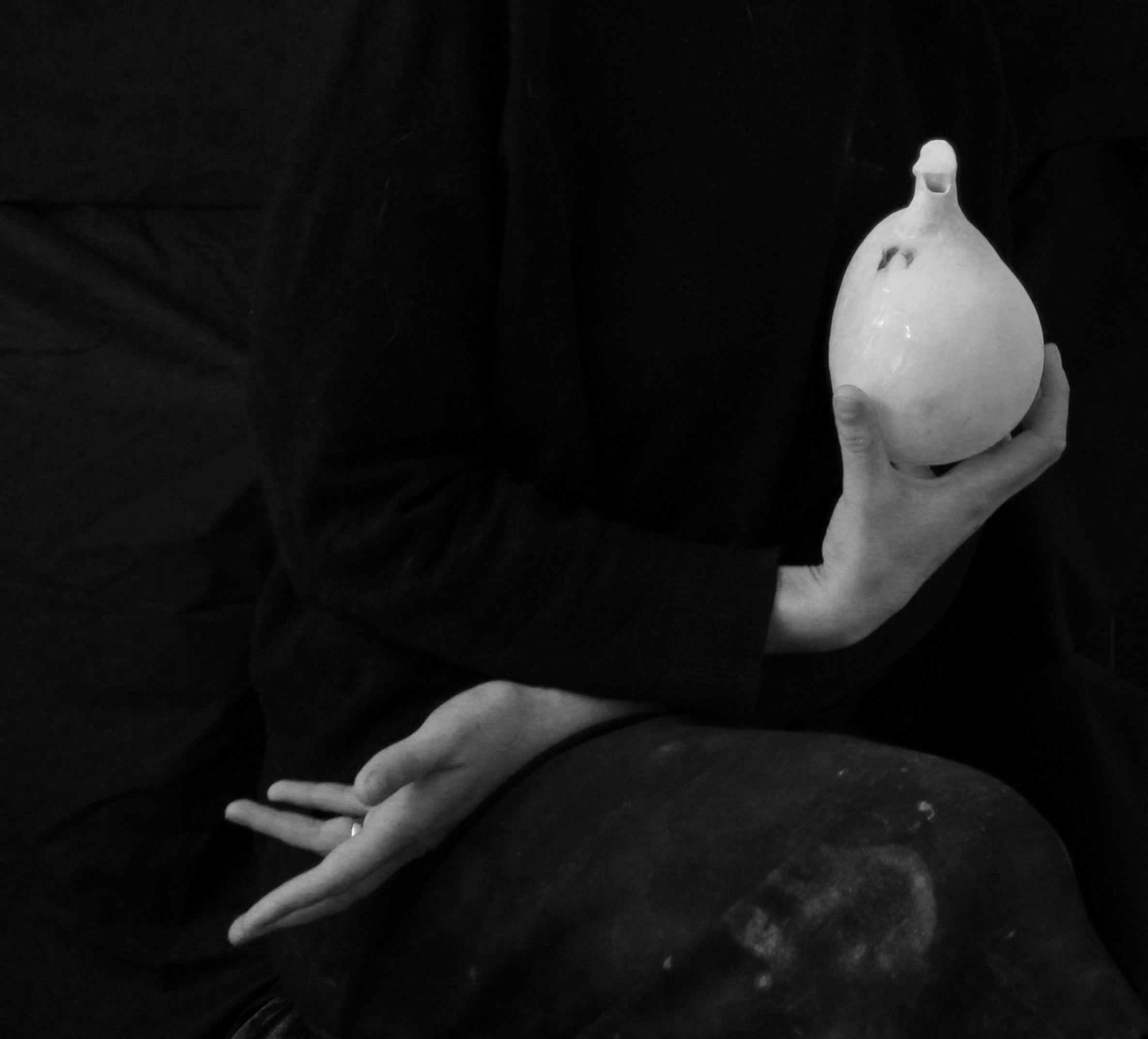
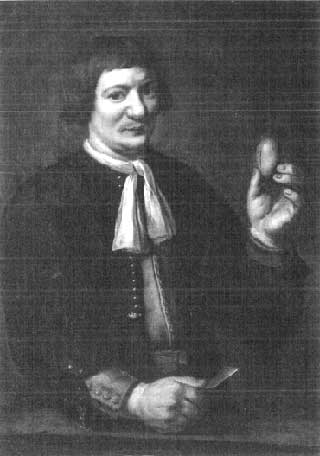
"Jeder neue Gegenstand, wohl beschaut, schließt ein neues Organ in ons af." [1]
[1] unnamed German poet, quoted in: Gaston Bachelard, La Poétique de la rêverie, PUF, Paris, 1984 (1960), p.143
February 20, 2021
Performance without public, KABK, The Hague, 2021
February 5, 2021
I told her I had conceived this work while sitting still, as I was working as a model in an art academy. I was focusing on the air I shared with the room, visualising each breath as a balloon, as a vessel, and, later on, as a clay whistle. I wondered about the sound of such a whistle; and, back home, I realised the object which had been in my mind.
She listened to the lamenting tone, and concluded: "The very nature of sound is to expand and fill up the room; but this sound stays where it is, it does not seek to conquer its surroundings. The object fits the situation where it has been conceived. It is, so to say, a sedentary sound".
January 20, 2021
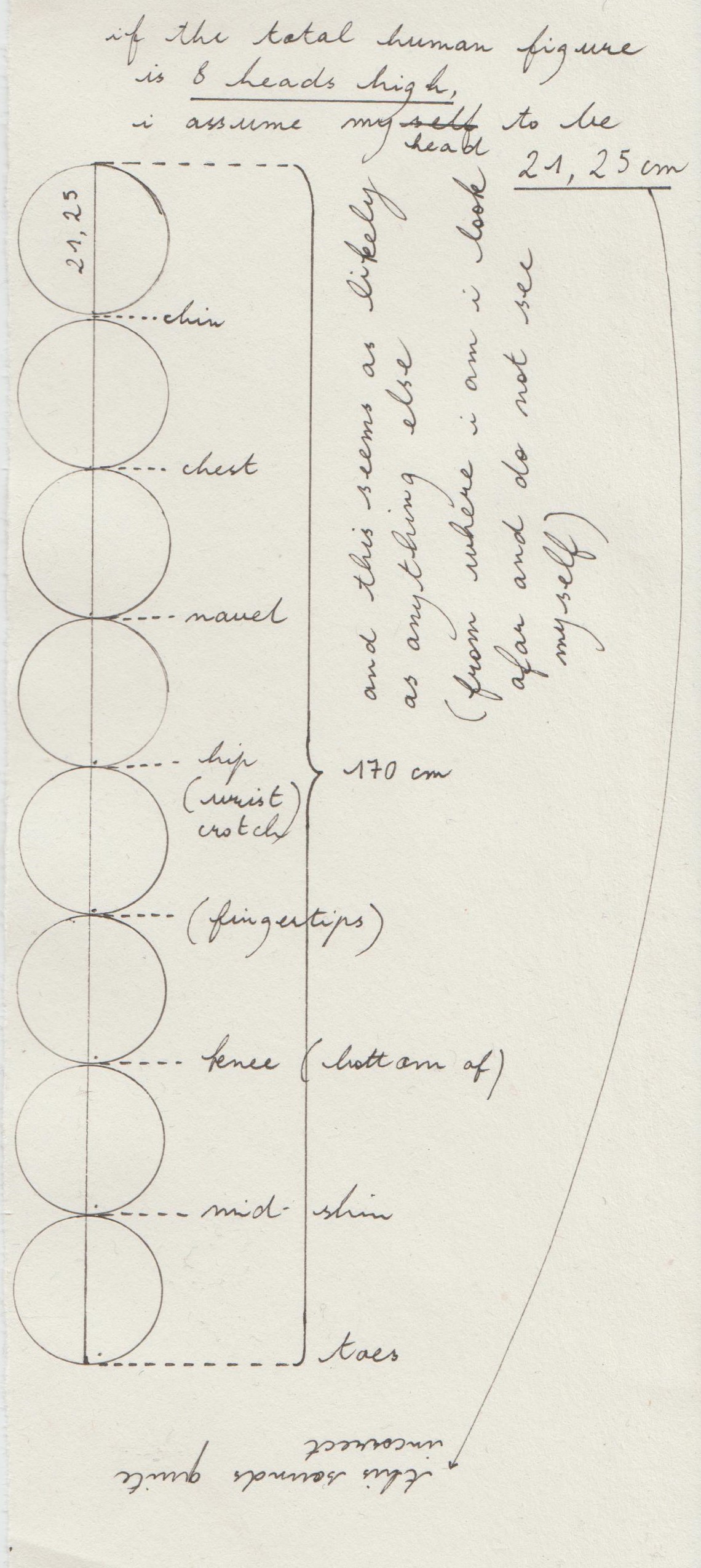
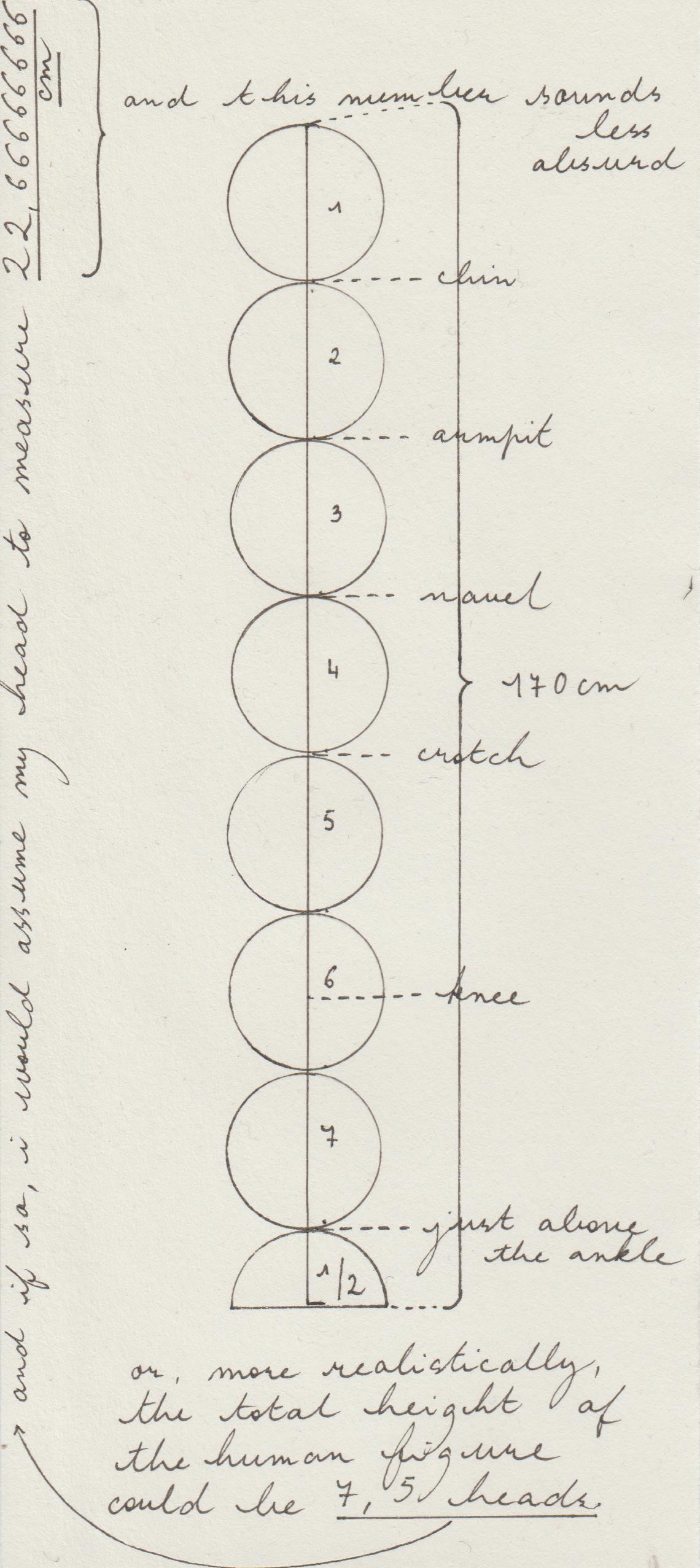
How High Is my Head Here, two sketches, fine liner on paper, 2021
December 11, 2020
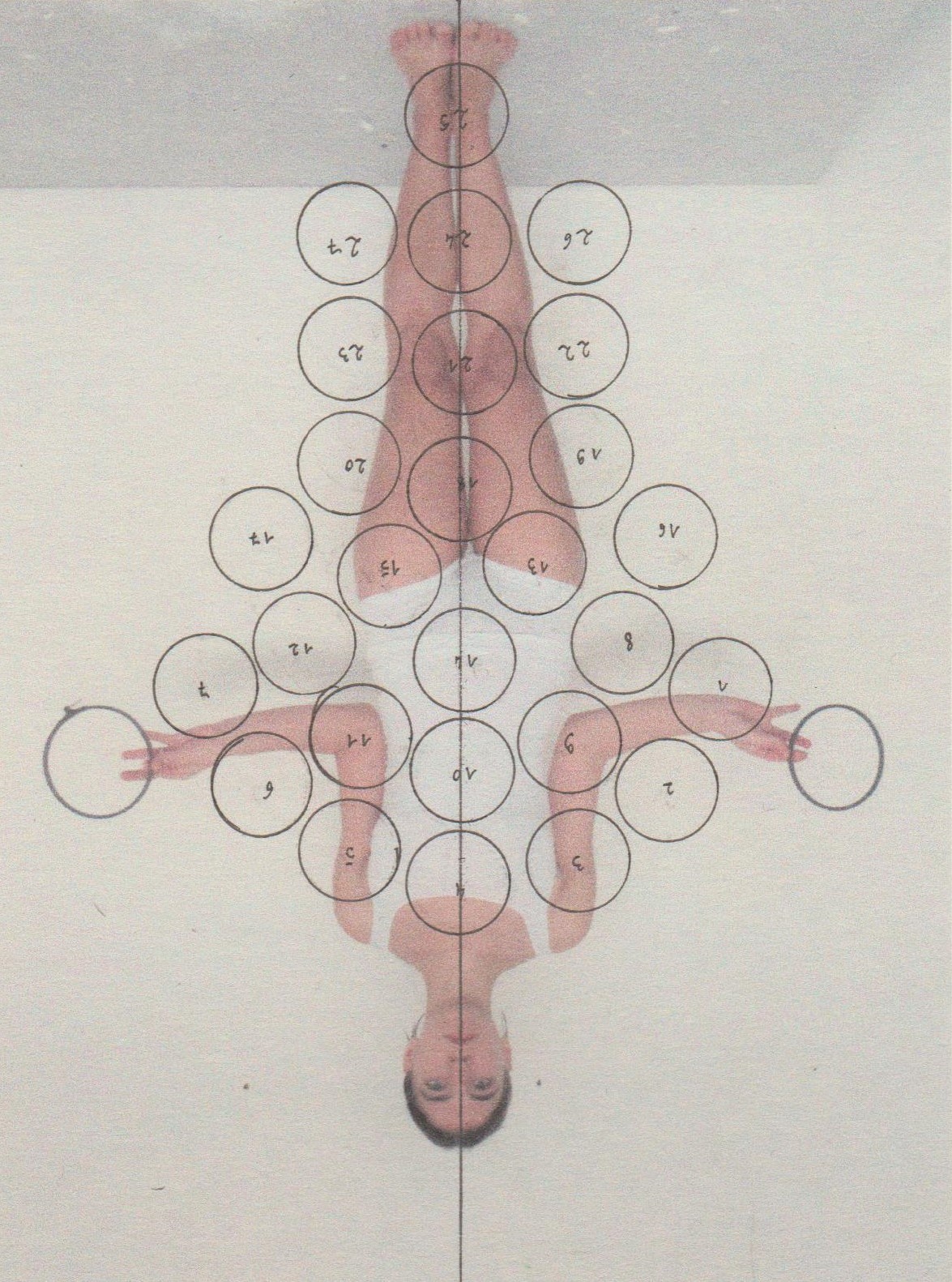
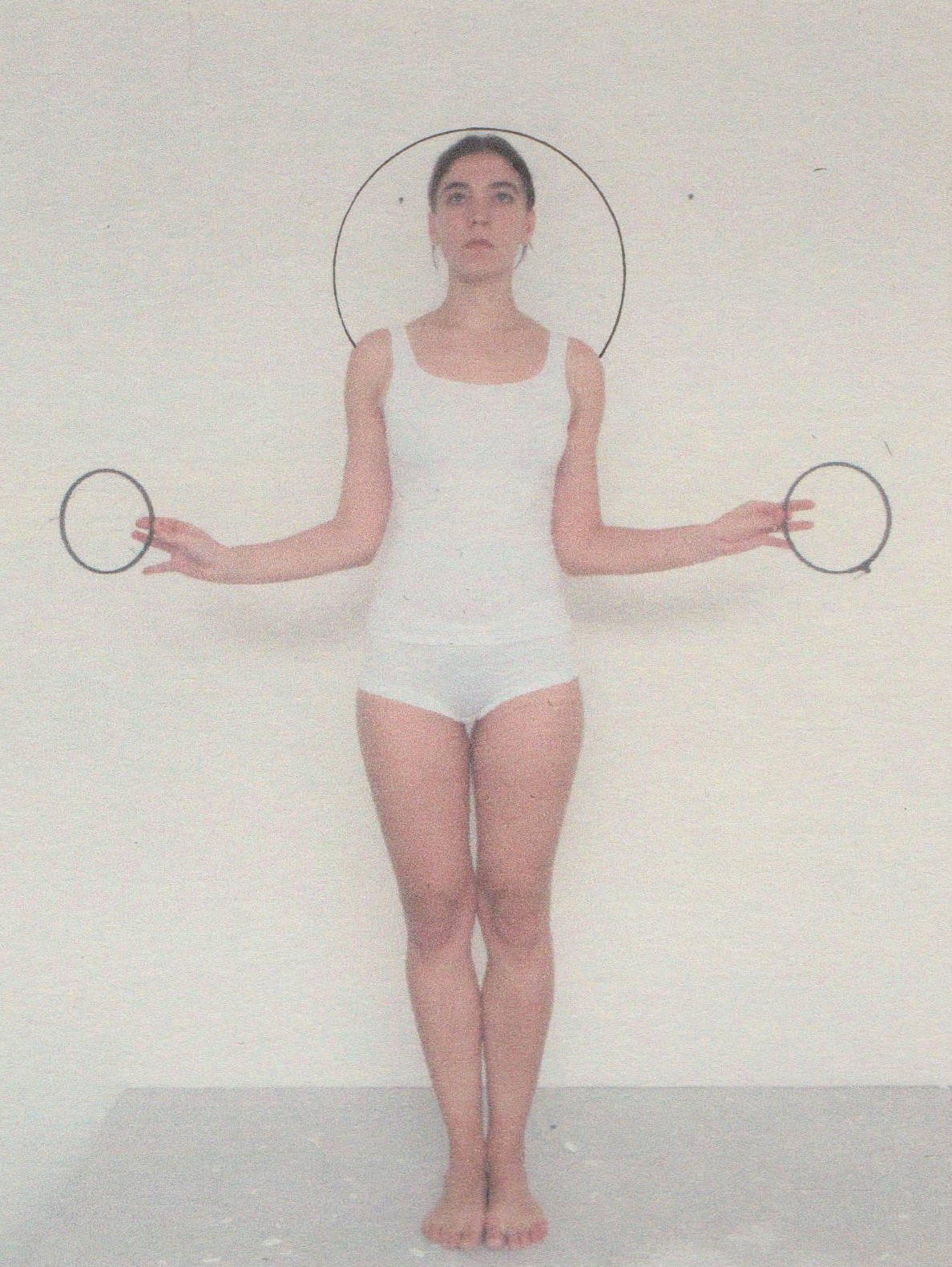
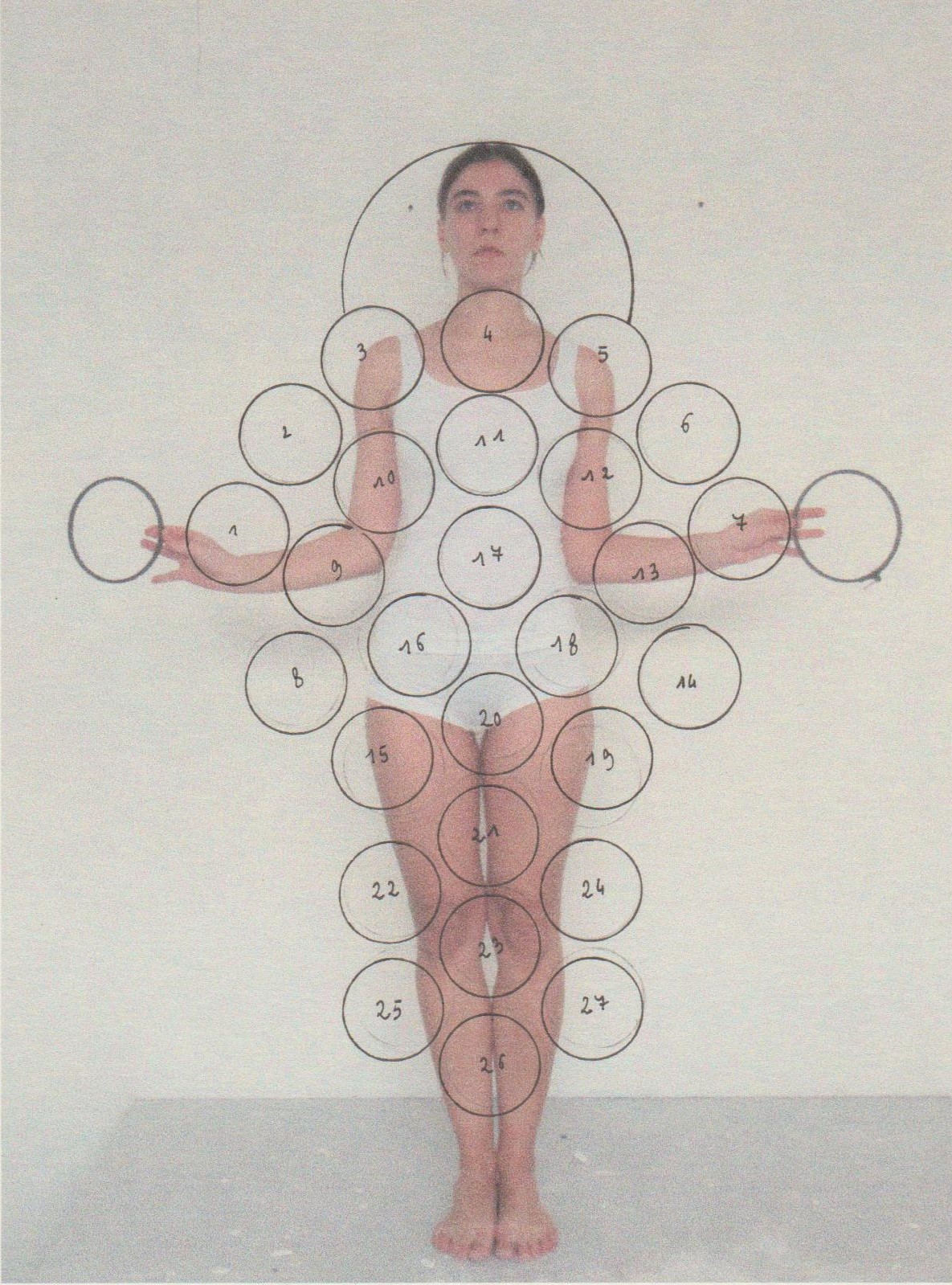 Sketches for the 27 breaths of Artemis, fineliner on inkjet print, 2020
Sketches for the 27 breaths of Artemis, fineliner on inkjet print, 2020October 15, 2020
The drawing conveyed the unease of a talented amateur: perfectly suckable breasts, but a nose one can't breathe through.
October 9, 2020
It is arbitrary to define photography as the 'Writing of Light', as the etymology suggests it. At first, the invention of photography also inspired other neologisms to describe this technique. Each of them appeared equally accurate.
These different terms derived from a limited number of Greek roots: phusis, auté, graphé, eikon, parastasis, aléthès:
Physautography (Writing of Nature Herself),
Parautophyse (Representation of Nature Herself),
Alétophyse (True Nature),
Phusalétotype (True Type of Nature),
Iconautophyse (Image of Nature Herself)... [1]
“Iconautophyse,” the model thought as she posed, “would also be suited to describe the image I am conceiving in my mind. The Image of Nature Herself is what I wish to draw, while being drawn after nature.”
[1] Monique Sicard, “La photo-graphie, entre nature et artefact”, in: Philippe Descola (dir), La Fabrique des Images, published by Somogy, Paris, 2010, p.116
These different terms derived from a limited number of Greek roots: phusis, auté, graphé, eikon, parastasis, aléthès:
Physautography (Writing of Nature Herself),
Parautophyse (Representation of Nature Herself),
Alétophyse (True Nature),
Phusalétotype (True Type of Nature),
Iconautophyse (Image of Nature Herself)... [1]
***
“Iconautophyse,” the model thought as she posed, “would also be suited to describe the image I am conceiving in my mind. The Image of Nature Herself is what I wish to draw, while being drawn after nature.”
[1] Monique Sicard, “La photo-graphie, entre nature et artefact”, in: Philippe Descola (dir), La Fabrique des Images, published by Somogy, Paris, 2010, p.116
September 26, 2020
I bear my bareness
as soldiers wear armours
and hermit crabs their shells.
(alles in orde)
as soldiers wear armours
and hermit crabs their shells.
(alles in orde)
September 16, 2020
I sat down, he sculpted
the Head of Medusa;
no one got petrified.
the Head of Medusa;
no one got petrified.
September 11, 2020
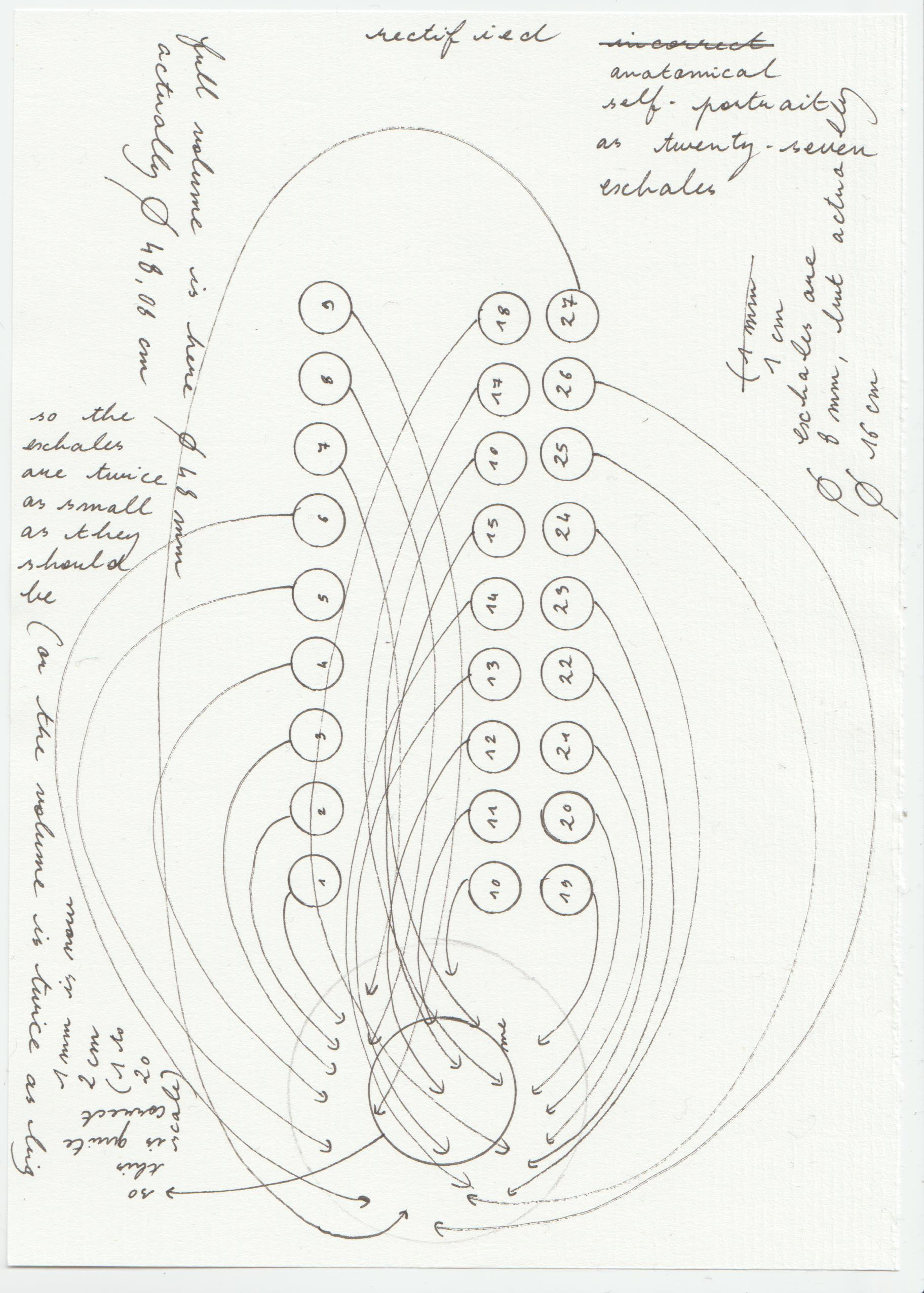 ‘Rectified anatomical self-portrait as 27 exhales’, fineliner on paper, 2020
‘Rectified anatomical self-portrait as 27 exhales’, fineliner on paper, 2020September 5, 2020
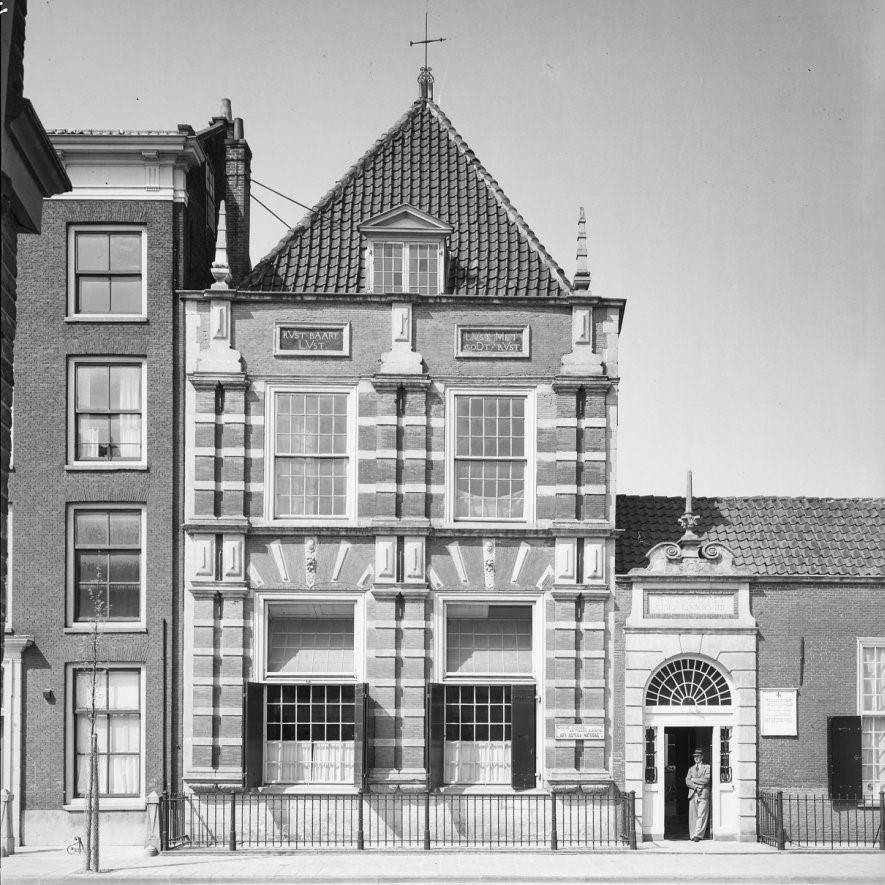
This is a building I am familiar with. It hosts a small art academy and is situated in the Pieterskerksgracht in Leiden. As a model, I have often looked out of the windows of the first floor. Yet, I never got a clear image of the architecture of the building, as the tree in the foreground (here a mere trunk on the left, hardly thicker than a twig) has grown large enough to hide the edifice behind a mist of greenery.
Here I can see: the windows I looked through are actually topped with inscriptions. Carved in stone, the words of the left window read: 'Rust baart lust', and the other ones: 'Lust met Godt rust'. I do not know if this motto was meant to refer to the artist's work, but it seems an accurate statement regarding the model's activity (sitting on a chair, beholding well-developed trees, in rapt attention.
(cropped picture from Rijksdienst voor het Cultureel Erfgoed)
August 30, 2020
The artist captured appearances;
and the model arresting them
could be held responsible
for half of the poaching.
and the model arresting them
could be held responsible
for half of the poaching.
August 27, 2020

I wonder, the model thought,
how many times I need to breathe in and out
to totally absorb the room enclosing me;
provided I can breathe a liter at a time;
that the life class is six meters by five,
and four meters high.
(image from: https://en.wikipedia.org/wiki/Filter_feeder)
June 19, 2020


In Leonardo da Vinci’s eyes, the human brain appeared wonderfully fluffy. One of his anatomical drawings shows blood capillaries running along its centerline as a hairy arborescence.
Actual human brains do not present such refined structure; however, these vascular patterns can be observed on those of cows. Drawing on his experience of previous dissections, da Vinci might have seen things which were not there.[1]
[1] Martin Clay and Ron Philo, Leonard de Vinci Anatomiste, published by Actes Sud, Arles, 2018
June 8, 2020

“I am my own reference framework”, the newborn protested.
(tracing after ‘Corpo do homem e do recem-nascido comparados pelo canone de Fritsch’, date unknown, author unkown)
(tracing after ‘Corpo do homem e do recem-nascido comparados pelo canone de Fritsch’, date unknown, author unkown)
June 2, 2020
Although our bodily dimensions are subject to change, it feels sound to me that we used to measure our surroundings with our own body parts: thumbs, feet, cubits, or steps.
Yet, this physical logic applied less directly to the units of volume than to those of length.
Instead of measuring with amphorae (Roman cubic foot), or any sort of bodily-proportioned vessels, we could have used our own bodies as vessels, and measure with mouthfuls and breaths.
Yet, this physical logic applied less directly to the units of volume than to those of length.
Instead of measuring with amphorae (Roman cubic foot), or any sort of bodily-proportioned vessels, we could have used our own bodies as vessels, and measure with mouthfuls and breaths.
May 31, 2020

Up: Andrew Loomis, ‘The basic shape is a flattened ball’, plate 1 in Drawing the Head and Hands, published by Chapman & Hall, London, 1956
Down: study for an Andrew Loomis helmet
May 30, 2020
While her pupils were drawing my portrait, she deemed useful to show them what my underlying structure looked like.
One of her cabinets contained a skull dedicated to this purpose.
— It is very well made, a pupil exclaimed, as she presented the skull close to my head. Or is it actually real?
— No, it is a cast, the teacher reacted; human remains cannot be traded off this way.
The pupil approached a bit closer, drawn by the naturalness of the object. Other classmates followed.
The skull was starting to awaken such curiosity that it gradually eclipsed my face.
— If you look at it carefully, the teacher continued, you will notice small latches on each temple.
— Can it open, really?
As a response, she unlocked the latches, revealing the intricate lining of the cranium.
I, too, witnessed this wonder: on the corner of my field of view, I could glimpse an inner world which was almost mine.
One of her cabinets contained a skull dedicated to this purpose.
— It is very well made, a pupil exclaimed, as she presented the skull close to my head. Or is it actually real?
— No, it is a cast, the teacher reacted; human remains cannot be traded off this way.
The pupil approached a bit closer, drawn by the naturalness of the object. Other classmates followed.
The skull was starting to awaken such curiosity that it gradually eclipsed my face.
— If you look at it carefully, the teacher continued, you will notice small latches on each temple.
— Can it open, really?
As a response, she unlocked the latches, revealing the intricate lining of the cranium.
I, too, witnessed this wonder: on the corner of my field of view, I could glimpse an inner world which was almost mine.
May 25, 2020
I felt at home there
but could not speak of it
as if I had swallowed
my mother tongue.
but could not speak of it
as if I had swallowed
my mother tongue.
April 29, 2020
As they turned their easels around,
none of the foursquare images
bore a striking likeness to me.
Still, I could recognize myself
in the tree I had long observed
(its lightness standing from the gloom
— sharp — through the frame of the window).
none of the foursquare images
bore a striking likeness to me.
Still, I could recognize myself
in the tree I had long observed
(its lightness standing from the gloom
— sharp — through the frame of the window).
April 25, 2020
Là, le modèle évalue la position de son corps à partir de son champ de vision: lorsqu’il vacille, il réalise son erreur par le trésaillement de son monde visuel.
Il connait la pression qu’il doit exercer sur son index afin que l’architecture de son corps reste stable, que le mirador reste à sa place, que ses yeux soient fixés à ce point précis du monde.
C’est la permanence du paysage au sommet de belvédère qui garantit la stabilité de l’édifice.
Il connait la pression qu’il doit exercer sur son index afin que l’architecture de son corps reste stable, que le mirador reste à sa place, que ses yeux soient fixés à ce point précis du monde.
C’est la permanence du paysage au sommet de belvédère qui garantit la stabilité de l’édifice.
There, the model evaluates the position of his body from his field of vision: when he falters, he realizes his error by the shattering of his visual world.
He knows the pressure he must exert on his index so that the architecture of his body remains stable, that the watchtower stays in its place, that his eyes remain fixed at this precise point of the world.
It is the permanence of the landscape at the top of the belvedere that guarantees the stability of the building.
He knows the pressure he must exert on his index so that the architecture of his body remains stable, that the watchtower stays in its place, that his eyes remain fixed at this precise point of the world.
It is the permanence of the landscape at the top of the belvedere that guarantees the stability of the building.
March 30, 2020
 Atmospheric perspective from the model's viewpoint, schema after JJ Gibson
Atmospheric perspective from the model's viewpoint, schema after JJ Gibson March 23, 2020

 Above: Korte stand met gelijke waarden, performance without public, 2020
Above: Korte stand met gelijke waarden, performance without public, 2020Below: Thetis and Peleus, detail from a kylix, ca. 490 BC
Februari 24, 2020
It was a stormy day, and I have spent it standing still, the eyes fixed on a waving tree. There and then, permanence had lost all naturalness.
February 15, 2020
 Torso from Jan Wolkers’ ‘Kort Amerikaans’, as displayed at Ars, February 2020
Torso from Jan Wolkers’ ‘Kort Amerikaans’, as displayed at Ars, February 2020February 8, 2020
He told me that salamanders could sit very still too, and that a recent study even reported the case of a specimen remaining motionless for seven whole years.
'Strange,' he added, 'given salamanders are evolved animals, gifted with a brain. What can a salamander think about for all those years, provided it thinks?'
'Strange,' I thought, 'our assumption that intelligence should be translated into motion, and that evolution is a headlong rush out of the inanimate realms.'
'Strange,' he added, 'given salamanders are evolved animals, gifted with a brain. What can a salamander think about for all those years, provided it thinks?'
'Strange,' I thought, 'our assumption that intelligence should be translated into motion, and that evolution is a headlong rush out of the inanimate realms.'
February 7, 2020
Same as Muybridge’s studies of motion, there exist, on a more discreet note, studies of motionlessness.
![]()
![]()
![]() Up: Detail from an anatomy book, handscanned at Ars Aemula Naturae (Leiden), in January 2020
Up: Detail from an anatomy book, handscanned at Ars Aemula Naturae (Leiden), in January 2020
Down: Picture from Brodie, Edmund D., et al. “Immobility as a Defensive Behavior in Salamanders.” Herpetologica, vol. 30, no. 1, 1974, pp. 79–85. JSTOR, www.jstor.org/stable/3891417. Accessed 7 Feb. 2020.

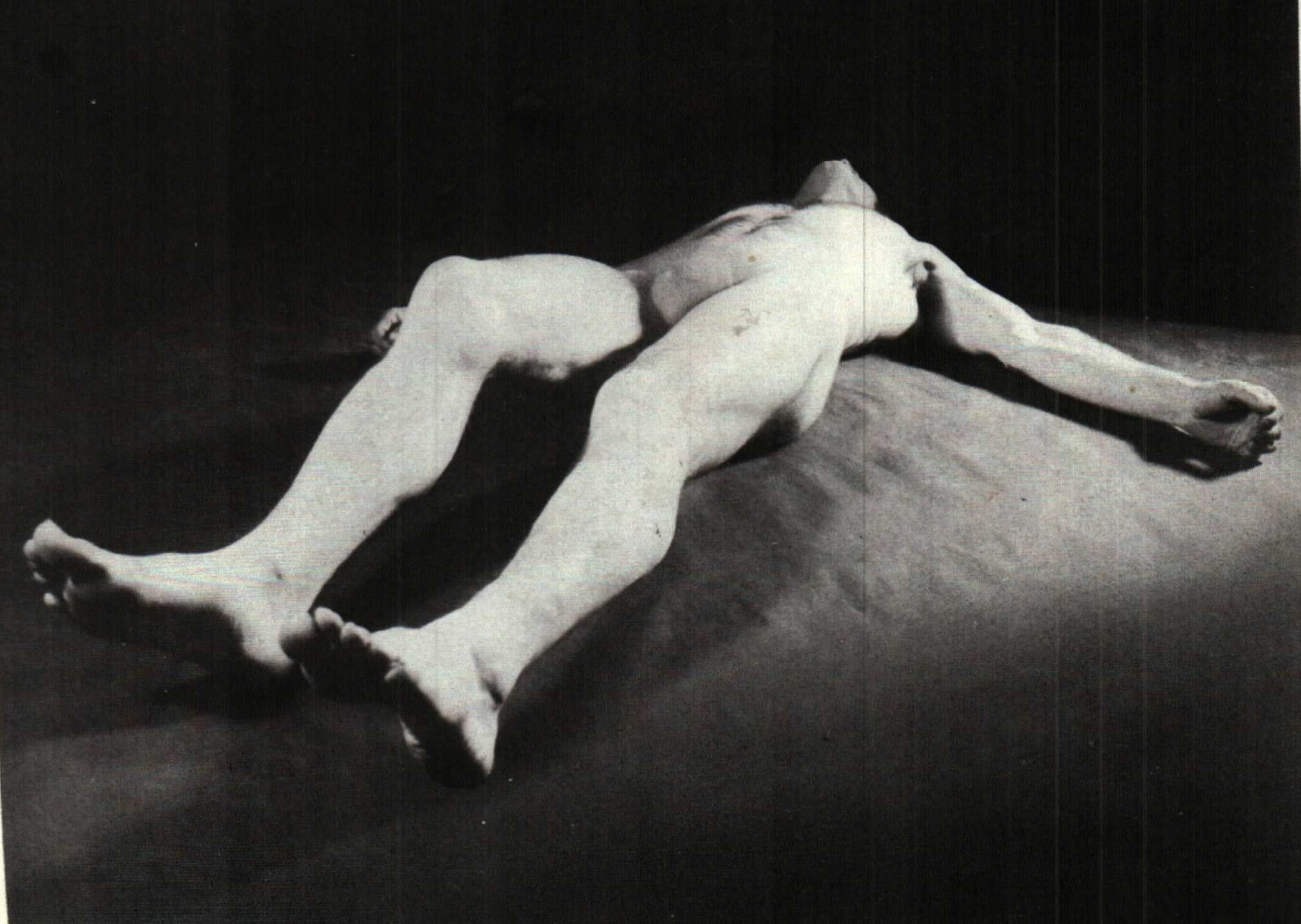
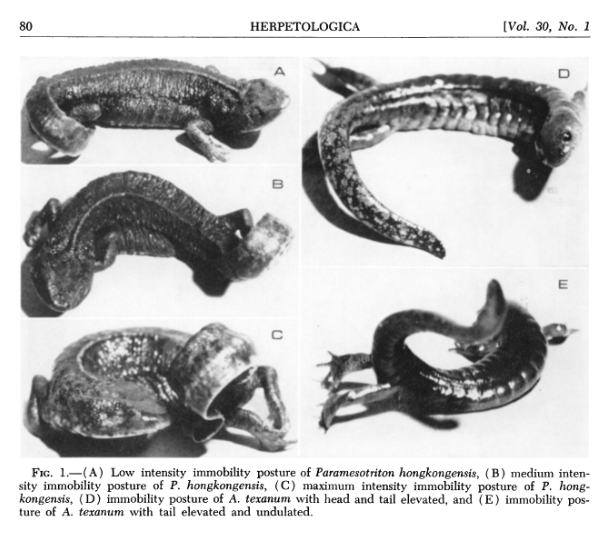 Up: Detail from an anatomy book, handscanned at Ars Aemula Naturae (Leiden), in January 2020
Up: Detail from an anatomy book, handscanned at Ars Aemula Naturae (Leiden), in January 2020
Down: Picture from Brodie, Edmund D., et al. “Immobility as a Defensive Behavior in Salamanders.” Herpetologica, vol. 30, no. 1, 1974, pp. 79–85. JSTOR, www.jstor.org/stable/3891417. Accessed 7 Feb. 2020.
February 5, 2020
The artist talked about fakirs, ecstasy and saints.
These comparisons were meant to express his model's motionlessness; but meanwhile, each term expelled her further in the geographical and historical distance.
'No,’ the model protested in herself, 'we keep inhabiting the same room, even now that we are experiencing different sensory worlds.’
These comparisons were meant to express his model's motionlessness; but meanwhile, each term expelled her further in the geographical and historical distance.
'No,’ the model protested in herself, 'we keep inhabiting the same room, even now that we are experiencing different sensory worlds.’
February 4, 2020
 ‘The Virgin, Patroness Saint of the Models, posing for Saint Luke’, handwritten caption on old postcard, 2020
‘The Virgin, Patroness Saint of the Models, posing for Saint Luke’, handwritten caption on old postcard, 2020February 3, 2020
February 2, 2020
- When I make a portrait of you, she told me, I do not simply reproduce your features; I also try to portray the inner world that is proper to you.
- And what is my inner world like?
- It is very still, very dreamy.
I had just spent three hours sitting on a chair, in order for her to finish this portrait. If any vivacity used to inhabit the sitter's inner world, the duration of the pose had swept it all away. It appeared to me that the inwardness she had observed was not mine, but that of the time we had both lived through.
- And what is my inner world like?
- It is very still, very dreamy.
I had just spent three hours sitting on a chair, in order for her to finish this portrait. If any vivacity used to inhabit the sitter's inner world, the duration of the pose had swept it all away. It appeared to me that the inwardness she had observed was not mine, but that of the time we had both lived through.
Februari 1, 2020
After the pose was set, I gazed at a wall of faux marble, leaning forward, in such a way that all the weight of my upper body was supported by my hand, which was resting at the edge of a prop.
I cannot remember the duration of this pose; it was surely long enough to lose sense of time.
When I came back to myself, I noticed the changed colors of my hand, and what I observed could not be distinguished from the marbled spectacle I had immersed myself in.
(marbleizing)
I cannot remember the duration of this pose; it was surely long enough to lose sense of time.
When I came back to myself, I noticed the changed colors of my hand, and what I observed could not be distinguished from the marbled spectacle I had immersed myself in.
(marbleizing)
January 21, 2020
The model sweats, she sweats profusely, and her smell starts mixing with the other fragrant materials of the life class: vegetal oils, turpentine spirits, animal glues.
Like theirs, her scent is not impure, but heavily present.
Like theirs, her scent is not impure, but heavily present.
January 15, 2020
By 'ecstatic viewpoint', I do not only mean 'the vision of the mystics', but also that of the snails and their erectile eyes.
January 11, 2020
Today, the occupants of the drawing room were middle-aged women aiming at making their first portrait. After hours of labour, one of them stated:
'In the end, drawing proves as difficult as giving birth.'
The humming that followed expressed disapproval.
'Perhaps more difficult, even,’ she reasserted, in a deeper voice.
'In the end, drawing proves as difficult as giving birth.'
The humming that followed expressed disapproval.
'Perhaps more difficult, even,’ she reasserted, in a deeper voice.
January 10, 2020
Following the academic tradition, one should not use the tip of the fingers to blend the hatched shadows of the drawing. Skin, even when dry and clean, naturally produces sebum, which will oil the parts that are rubbed, making them more difficult to erase at a later stage.
In other terms, the artist's body should be used as a proper tool, not as a binding agent for graphite. What is valued is a reasoned control over the image, not a dirty intimacy with it.
In other terms, the artist's body should be used as a proper tool, not as a binding agent for graphite. What is valued is a reasoned control over the image, not a dirty intimacy with it.
January 8, 2020
January 7, 2020
January 1, 2020
'Ars Aemula Naturae' ('Art is the rival of Nature') is an art academy in Leiden. It should not be confused with 'Natura Artis Magistra' (’Nature is the teacher of the Arts'), which is the name of the Amsterdam zoo.
I work as an art model in the first one, where a special emphasis is still placed on the practice of drawing after nature. Being in the position of 'nature', I assume that what I face is 'art'. There is no rivalry involved; however, I sometimes envy the position of the buffalo, the ostrich or the zebra, who are all thought to be able to teach.
I work as an art model in the first one, where a special emphasis is still placed on the practice of drawing after nature. Being in the position of 'nature', I assume that what I face is 'art'. There is no rivalry involved; however, I sometimes envy the position of the buffalo, the ostrich or the zebra, who are all thought to be able to teach.
December 31, 2019
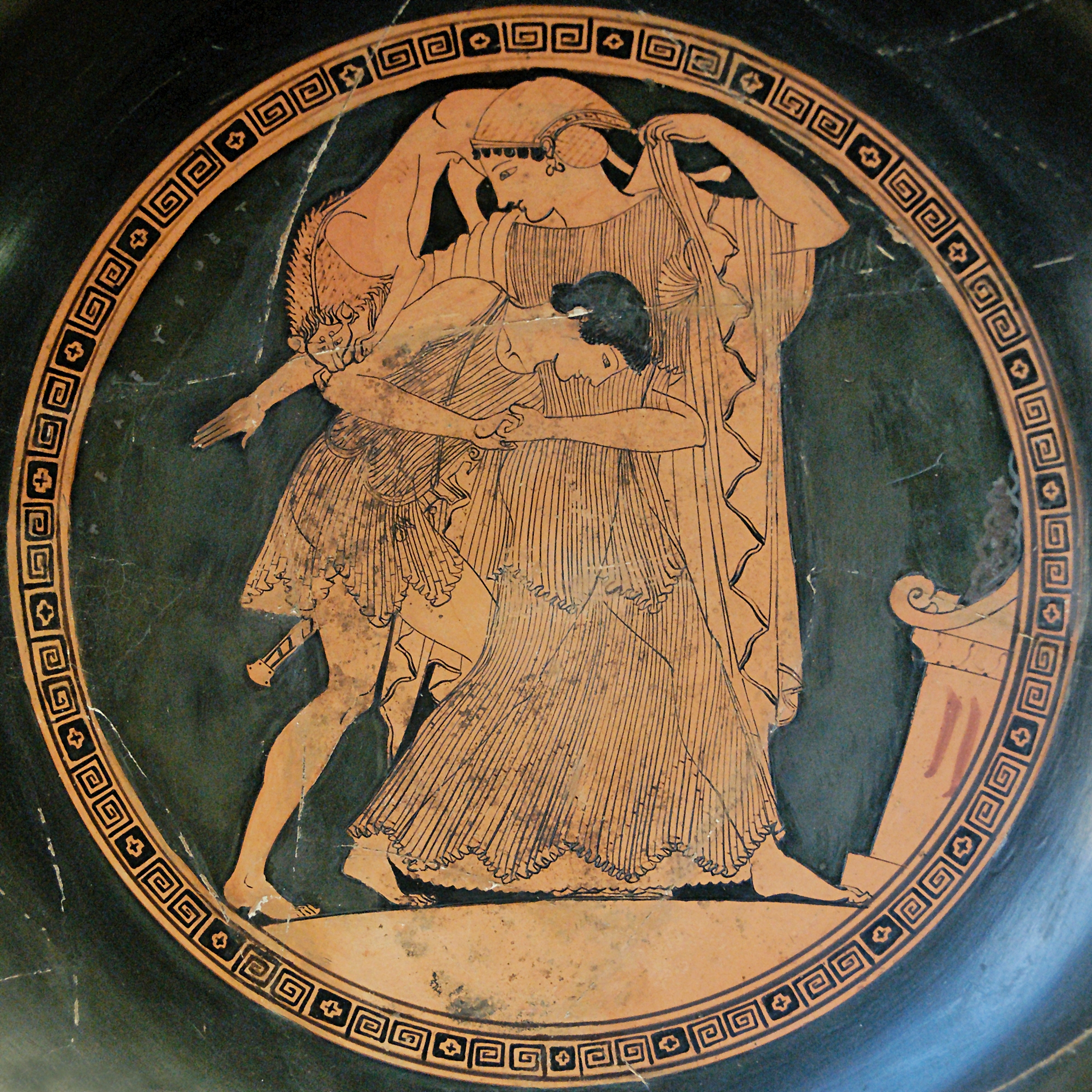 Thetis and Peleus, detail from a kylix, ca. 490 BC
Thetis and Peleus, detail from a kylix, ca. 490 BCShe feared to be known, and thus kept changing form.
Basics of self-defense.
December 30, 2019
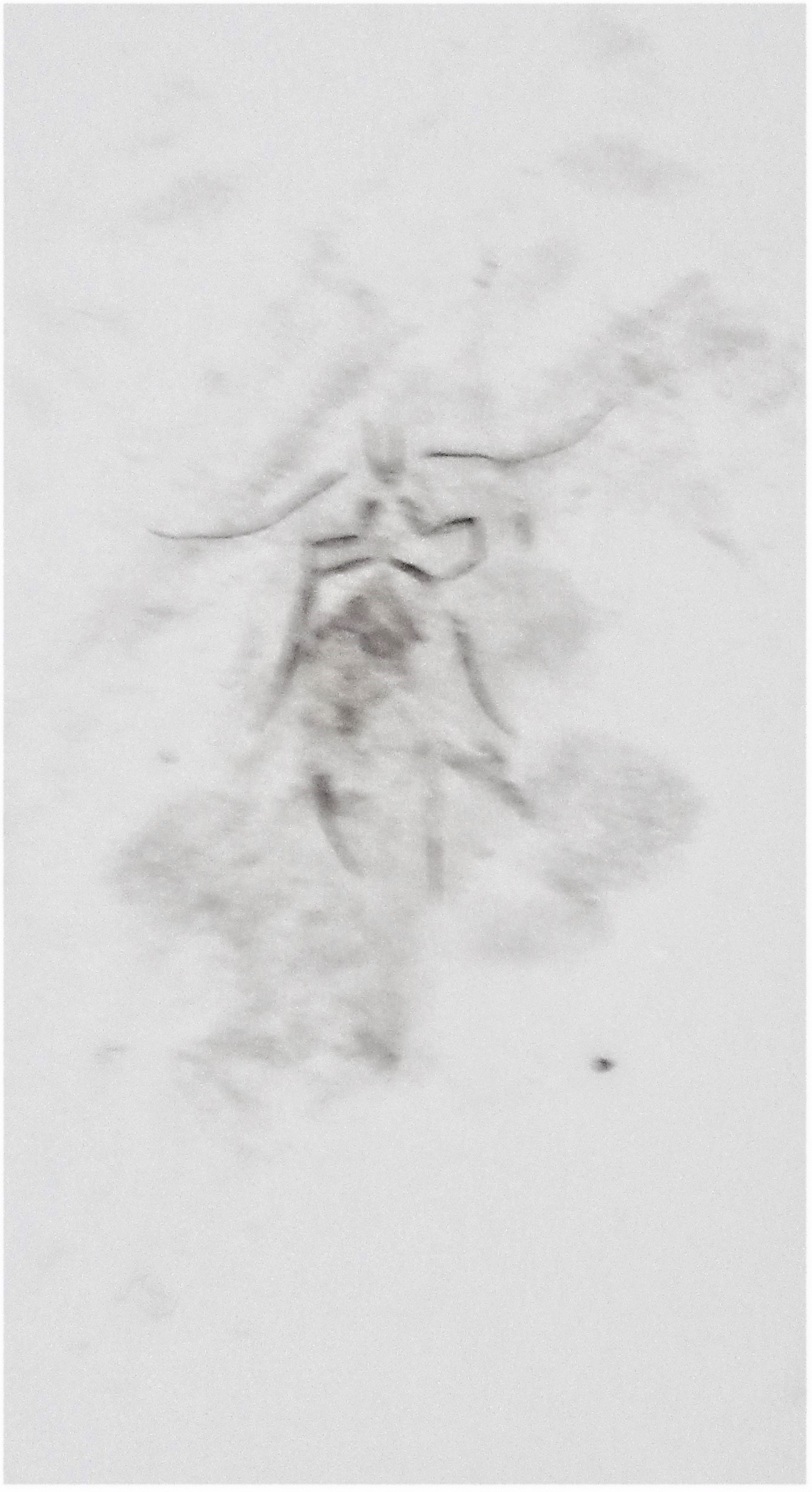
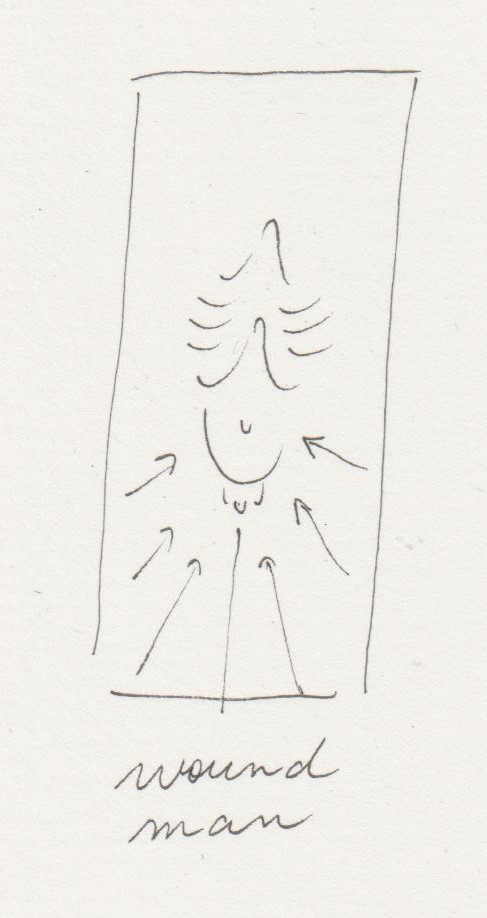
December 26, 2019
What a head contained was of little importance to the first anatomists. The earliest mention of the brain is found in an Egyptian medical papyrus, and this hieroglyph can be translated as 'skull offal'.[1]
[1] Susan Standring,‘A brief history of topographical anatomy’ in: Journal of Anatomy (2016) 229, p.32
October 23, 2019
In France, the weight of human beings is given by a device bearing a sophisticated name (pèse-personne), a name distinct from the instrument aimed at weighing any other thing (balance). The subject eludes his trivial heaviness by claiming a proper scale.
September 21, 2019
The blue discharge
For the prepubescent girl I was, sanitary napkins advertisements exerted a magical fascination. I had hardly encountered such refined imagery before (perhaps with the exception of the paintings of the Virgin Mary in her ultramarine mantle).
On the screen, shades of blue and white intertwined just as delicately. The fine structure of the napkin was first shown in its immaculate state, and then absorbing a deep-blue flow generously poured over its center. The napkin soaked it all up, while its whiteness barely altered: the beautiful blue left no stain, rather a glaze of pale turquoise over the whole surface.
For this reason, I believed this blue to be the actual menstrual color. In vain, I have longed for the day I would discover a lapis-lazuli stain on my linen.
For the prepubescent girl I was, sanitary napkins advertisements exerted a magical fascination. I had hardly encountered such refined imagery before (perhaps with the exception of the paintings of the Virgin Mary in her ultramarine mantle).
On the screen, shades of blue and white intertwined just as delicately. The fine structure of the napkin was first shown in its immaculate state, and then absorbing a deep-blue flow generously poured over its center. The napkin soaked it all up, while its whiteness barely altered: the beautiful blue left no stain, rather a glaze of pale turquoise over the whole surface.
For this reason, I believed this blue to be the actual menstrual color. In vain, I have longed for the day I would discover a lapis-lazuli stain on my linen.
August 20, 2019
She asked me what I wanted to become.
She said nowadays girls could become anything.
'May I also become a stone?' I asked.
(Back then, the Anthropocene was not a topic yet.)
![]() Self-portrait with coprolithe, 2018
Self-portrait with coprolithe, 2018
She said nowadays girls could become anything.
'May I also become a stone?' I asked.
(Back then, the Anthropocene was not a topic yet.)
 Self-portrait with coprolithe, 2018
Self-portrait with coprolithe, 2018July 15, 2019
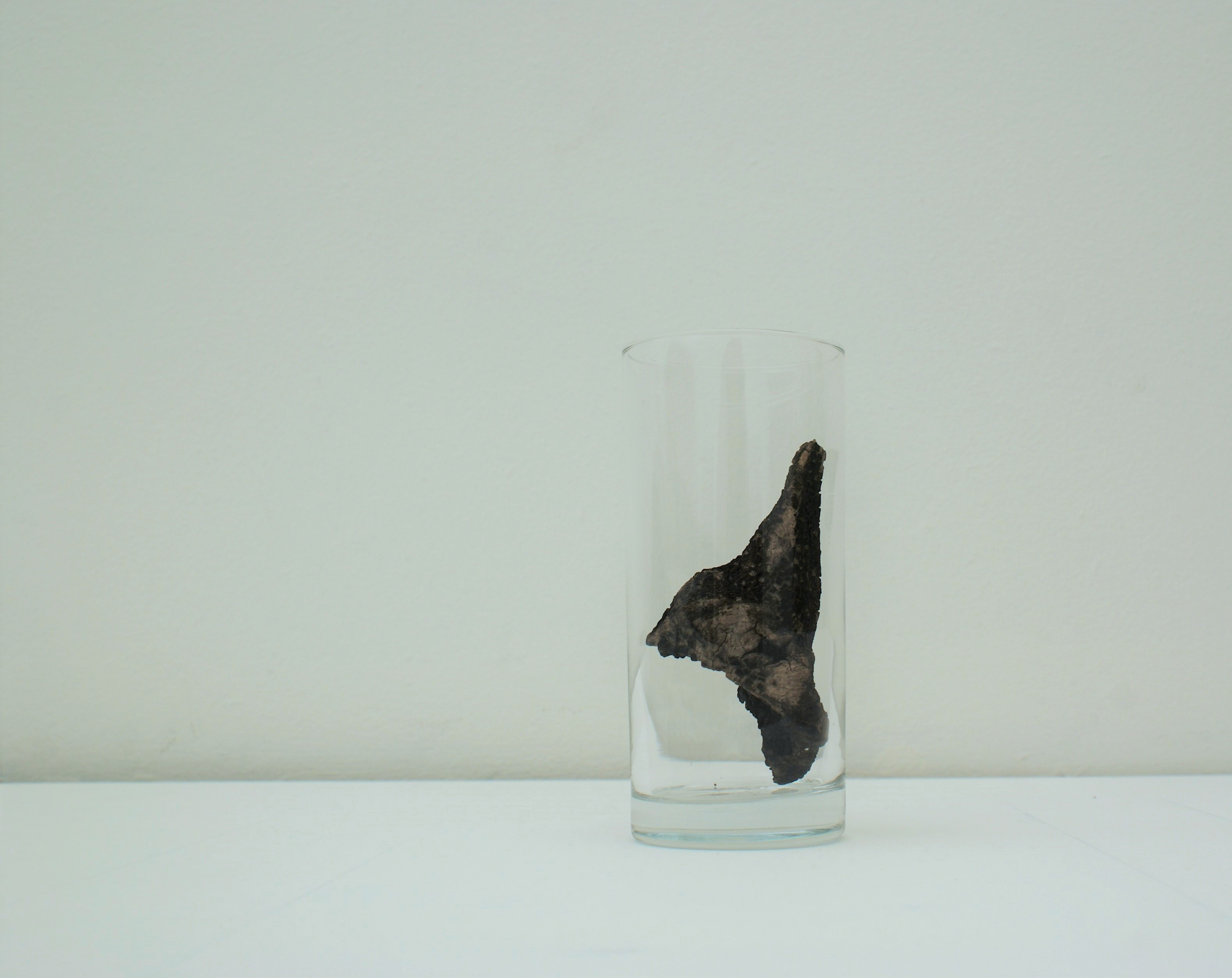
Drinking the residual space, performance without public, 2018
July 3, 2019
Dans The Practice and Science of Drawing, Harold Speed explique la médiocrité du dessinateur débutant par une indifférence spontanée pour les stimuli visuels, en comparaison aux stimuli tactiles.
L’enfant qui cherche à se nourrir se dirige à tâtons vers le corps maternel: le sens du toucher lui est le plus utile. Cette perception tactile et utilitariste du monde l’empêchera par la suite de voir les objets tels qu’ils sont, et de transmettre cette vision.
Ainsi, devant un paysage, l’homme se révèle plus attentif à l’étendue de la surface cultivable, à la boue qui empèse chacun de ses pas ou aux orties qui brûlent ses mollets qu’à l’image en train de s’inscrire sur sa rétine.
Je proposerai ici une hypothèse supplémentaire : si le monde pouvait blesser l’homme par les yeux aussi vivement qu’il sait le faire par la peau, son dessin s’en retrouverait amélioré, le sens visuel occupant alors chez lui une importance plus profonde.
L’enfant qui cherche à se nourrir se dirige à tâtons vers le corps maternel: le sens du toucher lui est le plus utile. Cette perception tactile et utilitariste du monde l’empêchera par la suite de voir les objets tels qu’ils sont, et de transmettre cette vision.
Ainsi, devant un paysage, l’homme se révèle plus attentif à l’étendue de la surface cultivable, à la boue qui empèse chacun de ses pas ou aux orties qui brûlent ses mollets qu’à l’image en train de s’inscrire sur sa rétine.
Je proposerai ici une hypothèse supplémentaire : si le monde pouvait blesser l’homme par les yeux aussi vivement qu’il sait le faire par la peau, son dessin s’en retrouverait amélioré, le sens visuel occupant alors chez lui une importance plus profonde.
March 20, 2018

Gif from A. W., My EMT class blowing up a cow lung, YouTube video, 2012
I once loved a boy,
and as I doubted to be loved in return,
I satisfied myself with the following thought:
Atmospheric air consists of
79% dinitrogen,
21% oxygen,
and some traces carbon dioxide.
The air we breathe out
contains de same amount of dinitrogen,
16 % oxygen,
and 5% carbon dioxide.
79% dinitrogen,
21% oxygen,
and some traces carbon dioxide.
The air we breathe out
contains de same amount of dinitrogen,
16 % oxygen,
and 5% carbon dioxide.
It was therefore reasonable to think
that some dioxygen molecules
could leach into his lungs,
and that the same elements,
as they were left untouched,
could join back the air of the classroom, to be eventually consumed through my organs.
A variation of this fantasy,
improbable acme of my teenage longings:
imagining that an infinitesimal fraction
of the carbon dioxide I was breathing in
had been rejected by his lungs
after havig been filtered out
of his blood.